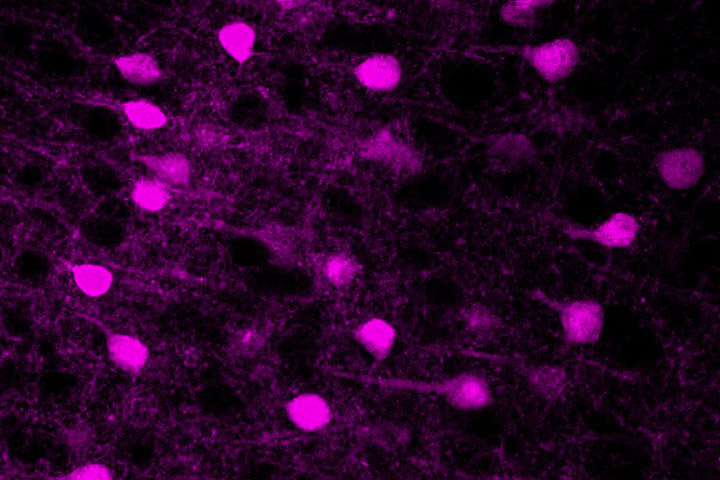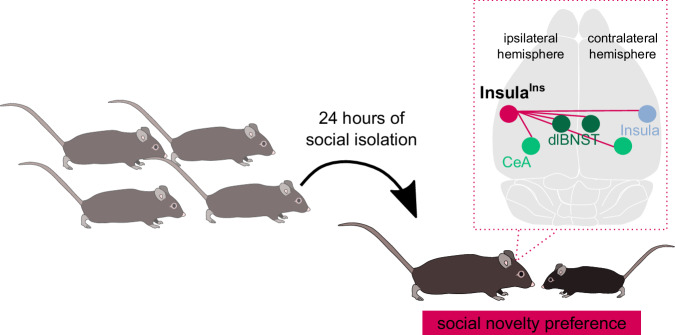
Christelle Glangetas et al in Nature Comm.
A team of researchers from IMN has unravelled the anatomical and functional properties of an Insula neuronal subpopulation projecting to the contralateral Insula. They uncovered that InsulaIns neurons are engaged in social preference only after 24 hours of social isolation in mice.
A recent study examines the role of Insula interhemispheric communication (InsulaIns) in social behaviour and anxiety in mice. The Insula, a key multisensory relay in socio-emotional processing, projects to various sensory, cognitive, emotional, and motivational regions. Among its many connections, the interhemispheric projection from the Insula to the contralateral Insula is particularly strong but remains poorly explored.
The authors used advanced techniques such as viral tracer neuroanatomy, ex vivo and in vivo electrophysiology, in vivo fiber photometry and targeted manipulation of neural circuits. These methods enabled them to elucidate the nature and role of this communication in shaping social and anxiety behaviour in mice. Three main objectives were defined for this study. The authors assessed: 1) an anatomical and molecular characterization of InsulaIns neurons, 2) an exploration of InsulaIns synaptic properties and circuits, 3) an examination of the role of InsulaIns neurons in social behaviour and anxiety state regulation, particularly after a period of social isolation.
The results show that InsulaIns neurons represent a distinct class within the Insula. In addition, the study demonstrates that stimulation of InsulaIns neurons leads to excitation in the interhemispheric circuit of the Insula, which is crucial for social discrimination after 24 hours of isolation in male mice. This suggests that these neurons are essential for processing social interactions after acute isolation.
In conclusion, this study highlights the importance of Insula interhemispheric communication in social processing and suggests that alterations in this communication could contribute to social deficits. It offers new insights into the neural mechanisms underlying social behaviors. This research could have important implications for a better understanding of autism spectrum disorders (ASD) and anxiety disorders, which are often associated with dysfunctions of the Insula and defects in sensory integration.
This research work was led by Christelle Glangetas and Francois Georges and implicated seven other team members of François Georges and Jérôme Baufreton‘s Team, at the Institute of Neurodegenerative Diseases (IMN) in Bordeaux: Adriane Guillaumin, Elodie Ladevèze, Anaelle Braine, Manon Gauthier, Léa Bonamy, Anne Taupignon and Jérôme Baufreton. This fruitful work was done in collaboration with two other IMN teams, Bezard’s and Landry’s team, and Stéphanie Caillé’s team at INCIA.

Summary schematic. InsulaIns neurons are required for social novelty preference only after 24 h of social isolation in male mice.
Reference
A population of Insula neurons encodes for social preference only after acute social isolation in mice
Christelle Glangetas1,#, Adriane Guillaumin1, Elodie Ladevèze1, Anaelle Braine1, Manon Gauthier1,2, Léa Bonamy1, Evelyne Doudnikoff1, Thibault Dhellemmes1, Marc Landry1, Erwan Bézard1, Stéphanie Caillé3, Anne Taupignon1, Jérôme Baufreton1, François Georges1,#
1 Univ. Bordeaux, CNRS, IMN, UMR 5293, F-33000 Bordeaux, France
2 Univ. Poitiers, Inserm, LNEC, U-1084, F-86000 Poitiers, France
3 Univ. Bordeaux, CNRS, INCIA, UMR5287, F-33000 Bordeaux, France
# Co-corresponding author. Emails: christelle.glangetas-bordeaux.fr, francois.georges-bordeaux.fr
Nat Commun. 2024-08-21
doi: 10.1038/s41467-024-51389-4
Last update 09/09/24
